|
|
 |
Fiche d'espèce de Copépode |
|
|
Calanoida ( Ordre ) |
|
|
|
Clausocalanoidea ( Superfamille ) |
|
|
|
Clausocalanidae ( Famille ) |
|
|
|
Clausocalanus ( Genre ) |
|
|
| |
Clausocalanus paululus Farran, 1926 (F,M) | |
| | | | | | | Ref.: | | | Farran, 1926 (p.240, Descr.F, figs.F); 1929 (p.208, 224); Rose, 1933 a (p.82, figs.F); Farran, 1936 a (p.82); Vervoort, 1957 (p.38, Rem.); 1963 b (p.118, Rem.); Tanaka, 1960 (p.33, figs.F); Frost & Fleminger, 1968 (p.62, figs.F,M, Rem.); Carli & Crisafi, 1969 (p.280, fig.F); Corral Estrada, 1970 (p.145, figs.M); Razouls, 1972 (p.94, Annexe: p.35, figs.F); Chen & Zhang, 1974 (p.103, 111, figs.F,M); Dawson & Knatz, 1980 (p.7, figs.F,M); Björnberg & al., 1981 (p.629, figs.F,M); Van der Spoel & Heyman, 1983 (p.44, fig.56); Bradford-Grieve, 1994 (p.123, figs.F,M, fig.101); Bradford-Grieve & al., 1999 (p.878, 916, figs.F,M); Bucklin & al., 2003 (p.335, tab.2, fig.1, Biomol); Conway & al., 2003 (p.183, figs.F,M, Rem.); Avancini & al., 2006 (p.81, Pl. 50, figs.F,M, Rem.); Vives & Shmeleva, 2007 (p.622, figs.F,M, Rem.) | 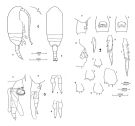 issued from : B. Frost & A. Fleminger in Bull. Scripps Inst. Oceanogr. Univ. California, San Diego, 1968, 12. [Pl. 47, p.194-195; Pl.48, p.196-197; Pl.49, p.198-199]. Female: 1 a, habitus (right lateral view); 1 b, idem (dorsal view); 1 c, rostrum (right lateral); a-b taken from same specimen, c ffrom another specimen; 2 a, Th.4-5 (posterior part) and genital segment (right lateral); 2 b-c, genital segment with some of accessory material of spermatophore neck attached to seminal receptacle (ventral view); 2 d, ventral half of genital segment (right lateral); 2 e-f, B2 of P2; 2 g-i, B2 of P3; 2 j, St of P2; 2 k, Re3 and St of P3; 2 l, Re3 and St of P4; taken from different specimens; 3 a-b, Th.4-5 (posterior part) and urosome with spermatophore attached (right lateral; 3, c-d, P5; taken from different specimens. Nota: Distance L between basipodal spiniform processes 2 and 3 of P3 more than 2.0 times width D (see figure in Clausocalanus lividus Pl.1, c for processes 2 and 3, and L, D).
|
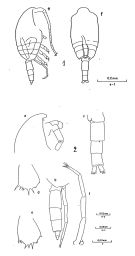 issued from : B. Frost & A. Fleminger in Bull. Scripps Inst. Oceanogr. Univ. California, San Diego, 1968, 12. [Pl. 49, p.198-199; Pl.50, p.200-201]. Male: 1 e, habitus (right lateral view); 2 f, idem (dorsal view); 2 a, frontal region (right lateral view); 2b, Th.4-5 (posterior part) and urosome (right lateral); 2 c, urosome (dorsal view); 2 d, B2 of P2; 2 e, B2 of P3; 2 f, P5 (anterior); taken from different specimens, except 2 c-f (third specimen) and d-e (fourth specimen). Nota: Total body length less than 0.70 mm.
|
 issued from : C. Razouls in Thèse Doc. ès Sciences, Univ. P & M. Curie, Paris , Tome annexe, 1972, Fig.36 (unpublished). Female (from Banyuls): A, habitus (lateral left side); B, urosome (ventral); C, P5; D, E, basipod of P2; F, F', F'' basipod of P3.
|
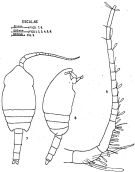 issued from : J. Corral Estrada in Tesis Doct., Univ. Madrid, A-129, Sec. Biologicas, 1970. [Lam.40, figs.7-9]. Male (from Canarias Is.): 7, habitus (dorsal); 8, idem (lateral right side); 9, A1.
|
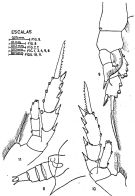 issued from : J. Corral Estrada in Tesis Doct., Univ. Madrid, A-129, Sec. Biologicas, 1970. [Lam.41, figs.1-7]. Male: 1, urosome (dorsal); 2, P1; 3, P2; 4, P3; 5, P4; 6, P5; 7, distal part of P5.
|
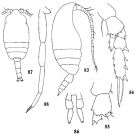 issued from : Q.-c .Chen & S.-z. Zhang in Studia Marina Sinica, 1974, 9. [Pl.7, Figs.83-88]. Female (from South China Sea): 83, habitus (lateral right side); 84, P2; 85, basipodite 2 of P3; 86, P5. Male: 87, habitus (dorsal); 88, P5.
|
 issued from : B. Frost & A. Fleminger in Bull. Scripps Inst. Oceanogr. Univ. California, 1968, 12. [p.46, Table 3a]. Clausocalanus paululus Females: Measurements and ratios . TL = total body length ; SL = spermatophore length ; P :U = ratio of prosome length to urosome length ; U :U1 = ratio of total urosome length to length of 1st urosomal segment (genital segment) ; S :U1 = ratio of spermatophore sac length to U1 length of female on which spermatophore is attached ; r = sample range; m = sample mean; n = number of specimens measured; s = sample standard deviation.
|
 issued from : B. Frost & A. Fleminger in Bull. Scripps Inst. Oceanogr. Univ. California, 1968, 12. [p.47, Table 3b]. Clausocalanus paululus Males: Measurements and ratios . TL = total body length; P :U = ratio of prosome length to urosome length ; P:U2 = ratio of prosome length to length od 2nd urosomal segment; U2:2P5 = ratio of U2 length to length of 2nd segment of longer ramus of P5; U2:3P5 = ratio of U2 length of 3rd segment of longer ramus of P5; 3P5:2P5 = ratio of length of 3P5 of longer ramus to length of 2P5 of longer ramus; r = sample range; m = sample mean; n = number of specimens measured; s = sample standard deviation.
|
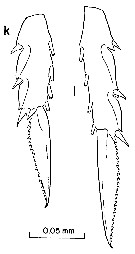 issued from : B. Frost & A. Fleminger in Bull. Scripps Inst. Oceanogr. Univ. California, 1968, 12. [p.197, Pl.48, k, l]. Female: k, exopodal segment 3 and terminal seta of P3; l, exopodal segment 3 and terminal seta of P4. (from different specimens).
|
 issued from : B. Frost & A. Fleminger in Bull. Scripps Inst. Oceanogr. Univ. California, 1968, 12. [p.197, Pl.48, e-f, g-i]. Female: ef, basipodite 2 of P2; g-i, basipodite 2 of P3. e, g, same specimen; f-h, another specimen; i, different specimen.
|
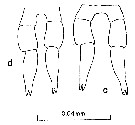 issued from : B. Frost & A. Fleminger in Bull. Scripps Inst. Oceanogr. Univ. California, 1968, 12. [p.199, Pl.49, c-d]. Female: c-d, P5 (from different specimens).
|
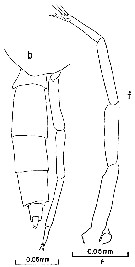 issued from : B. Frost & A. Fleminger in Bull. Scripps Inst. Oceanogr. Univ. California, 1968, 12. [p.201, Pl.50, b, f]. Male: b, posterior part of last thoracic segment and urosome (right lateral); f, P5 (anterior).
|
 issued from : B. Frost & A. Fleminger in Bull. Scripps Inst. Oceanogr. Univ. California, 1968, 12. [p.201, Pl.50, d, e]. Male: d, basipodite 2 of P2; e, basipodite 2 of P3. From different specimens.
|
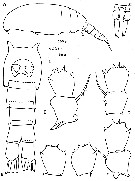 issued from : C. Razouls in Th. Doc. Etat Fac. Sc. Paris VI, 1972, Annexe. [Fig.36]. Female (from Banyuls, G. of Lion): A, habitus (lateral); B, urosome (dorsal); C, P5; D-E, basipod 2 of P2; , F' and F'', basipod 2 of P3.
|
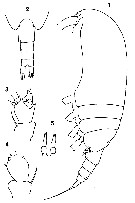 Issued from : O. Tanaka in Spec. Publs. Seto mar. biol. Lab., 10, 1960 [Pl. XII, 1-5]. Female (from 18°54'S, 60°39'E): 1, habitus (lateral); 2, abdomen (dorsal); 3, basis of P2; 4, basis of P3; 5, P5. 1 and 2, same scale; 3-5 same scale. Nota: Cephalothorax and abdomen in the proportional lengths 73 to 27. Rostral spine slender, curved slightly backwards. Abdomen 4-segmented; segments and caudal rami in the proportional lengths 38 : 20 : 18 : 10 : 14 = 100. Genital segment slightly produced below. Caudal rami 1.25 times as long as broad. Basis of P2 with 5 slender spines on the distal border. P3 with 4 spines on the distal border of the basis. P4 without distal spines on the basis. P5 3-segmented; distal segment deeply notched at the apex.
| | | | | Ref. compl.: | | | Duran, 1963 (p.15, as paulus); Grice & Hart, 1962 (p.287, table 3, p.293: Rem.); V.N. Greze, 1963 a (tabl.2); Shmeleva, 1963 (p.141); De Decker, 1964 (p.15, 20, 29); De Decker & Mombeck, 1964 (p.12); Shmeleva, 1965 b (p.1350, lengths-volume-weight relation); Grice & Hulsemann, 1965 (p.223); Mazza, 1966 (p.70); Pavlova, 1966 (p.43); Grice & Hulsemann, 1967 (p.14); Fleminger, 1967 a (tabl.1); Delalo, 1968 (p.137); Champalbert, 1969 a (p.635, as paulus); Park, 1970 (p.475); Gamulin, 1971 (p.381, tab.2); Deevey, 1971 (p.224); Apostolopoulou, 1972 (p.327, 343); Fleminger & Hulsemann, 1973 (p.340, chart); Corral Estrada & Pereiro Muñoz, 1974 (tab.I); Peterson & Miller, 1976 (p.14, Table 1, 3, abundance vs interannual variations); 1977 (p.717, Table 1, seasonal occurrence); Carter, 1977 (1978) (p.35); Kovalev & Schmeleva, 1982 (p.83); Vives, 1982 (p.290); Scotto di Carlo & al., 1984 (p.1041); Longhurst, 1985 (tab.2); Regner, 1985 (p.11, Rem.: p.29); Brenning, 1985 a (p.28, Table 2); Greze & al., 1985 (p.7); Madhupratap & Haridas, 1986 (p.105, tab.1); Lozano Soldevilla & al., 1988 (p.58); Scotto di Carlo & al., 1991 (p.271); Shih & Young, 1995 (p.72); Errhif & al., 1997 (p.422); Hure & Krsinic, 1998 (p.100); Noda & al., 1998 (p.55, Table 3, occurrence); Mauchline, 1998 (tab.30, 58); Suarez-Morales & Gasca, 1998 a (p109); Siokou-Frangou, 1999 (p.476); Siokou-Frangou & al., 1999 (p.205, Table 5); Moraitou-Apostolopoulou & al., 2000 (tab.I); Madhupratap & al., 2001 (p. 1345, vertical distribution vs. O2, fig. 4: clusters, Rem.: p.1353); Fragopoulu & al., 2001 (p.49, tab.1); Lo & al., 2001 (1139, tab.I); Sameoto & al., 2002 (p.12); Peterson & al. (p.381, Table 2, interannual abundance); Vukanic, 2003 (139, tab.1); Peralba & Mazzocchi, 2004 (p.645, figs.3,6); Vukanic & Vukanic, 2004 (p.9, tab. 2, 3); Licandro & al., 2005 (p.153); Isari & al., 2006 (p.241, tab.II); Zervoudaki & al., 2006 (p.149, Table I); Hooff & Peterson, 2006 (p.2610); Fernandez de Puelles & al., 2007 (p.338, fig.7); Valdés & al., 2007 (p.103: tab.1); McKinnon & al., 2008 (p.844: Tab.I, p.848: Tab. IV); Cabal & al., 2008 (289, Table 1); Galbraith, 2009 (pers. comm.); Tseng & al., 2009 (p.327, fig.5, feeding); Brugnano & al., 2010 (p.312, Table 3, fig.8); Cornils & al., 2010 (p.2076, Table 3); Schnack-Schiel & al., 2010 (p.2064, Table 2: E Atlantic subtropical/tropical, Fig.4, 6, 7, Tabe 4); Mazzocchi & Di Capua, 2010 (p.425); Medellin-Mora & Navas S., 2010 (p.265, Tab. 2); Selifonova, 2011 a (p.77, Table 1, alien species in Black Sea); Mazzocchi & al., 2011 (p.1163, Table II, fig.6, long-term time-series 1984-2006); Isari & al., 2011 (p.51, Table 2, abundance vs distribution); Mazzocchi & al., 2012 (p.135, annual abundance 1984-2006); Shiganova & al., 2012 (p.61, Table 4); Uysal & Shmeleva, 2012 (p.909, Table I); Salah S. & al., 2012 (p.155, Tableau 1); Miloslavic & al., 2012 (p.165, Table 2, transect distribution); Brugnano & al., 2012 (p.207, Table 3); Krsinic & Grbec, 2012 (p.57, 67: abundance); Takahashi M. & al., 2012 (p.393, Table 2, water type index); in CalCOFI regional list (MDO, Nov. 2013; M. Ohman, comm. pers.); Lidvanov & al., 2013 (p.290, Table 2, % composition); Siokou & al., 2013 (p.1313, fig.4, 8, biomass, vertical distribution); Pansera & al., 2014 (p.221, Table 2, abundance); Mazzocchi & al., 2014 (p.64, Table 3, 4, 5, spatial & seasonal composition %); Zaafa & al., 2014 (p.67, Table I, occurrence); Fernandez de Puelles & al., 2014 (p. in press, Table 3); Benedetti & al., 2016 (p.159, Table I, fig.1, functional characters); El Arraj & al., 2017 (p.272, table 2, spatial distribution); Benedetti & al., 2018 (p.1, Fig.2: ecological functional group); Belmonte, 2018 (p.273, Table I: Italian zones); Chaouadi & Hafferssas, 2018 (p.913, Table II: occurrence); Hure M. & al., 2018 (p.1, Table 1: abundance, % composition, Rem.: p.12). | | | | NZ: | 16 | | |
|
Carte de distribution de Clausocalanus paululus par zones géographiques
|
| | | | | | | | | | | |  issued from : B. Frost & A. Fleminger in Bull. Scripps Inst. Oceanogr. Univ. California, San Diego, 1968, 12. [p.64, Chart 9, a]. issued from : B. Frost & A. Fleminger in Bull. Scripps Inst. Oceanogr. Univ. California, San Diego, 1968, 12. [p.64, Chart 9, a].
Occurrence of C. paululus in samples examined; closed circles represent samples examined; open circles represent samples in which adults were found; bars through open circles represent samples from which specimens were removed for measurements. |
 issued from : B. Frost & A. Fleminger in Bull. Scripps Inst. Oceanogr. Univ. California, San Diego, 1968, 12. [p.65, Chart 9, b]. issued from : B. Frost & A. Fleminger in Bull. Scripps Inst. Oceanogr. Univ. California, San Diego, 1968, 12. [p.65, Chart 9, b].
Occurrence of C. paululus in samples examined; closed circles represent samples examined; open circles represent samples in which adults were found; bars through open circles represent samples from which specimens were removed for measurements. |
 issued from : A.A. Shmeleva in Bull. Inst. Oceanogr., Monaco, 1965, 65 (n°1351). [Table 6: 15 ]. Clausocalanus paululus (from South Adriatic). issued from : A.A. Shmeleva in Bull. Inst. Oceanogr., Monaco, 1965, 65 (n°1351). [Table 6: 15 ]. Clausocalanus paululus (from South Adriatic).
Dimensions, volume and Weight wet. Means for 50-60 specimens. Volume and weight calculated by geometrical method. Assumed that the specific gravity of the Copepod body is equal to 1, then the volume will correspond to the weight. |
| | | | Loc: | | | Sub-Antarct., South Africa (W & E), S Brazil, off Amazon, off Morocco-Mauritania, Cap Ghir (Morocco), Canary Is., off Madeira, Azores, Bay of Biscay, Caribbean Sea, Caribbean Colombia, G. of Mexico, Florida, Sargasso Sea, off Bermuda, off E Nova Scotia, off W Tangier, Medit. (Alboran Sea, Sidi Fredj coast, Baleares, Banyuls G. of Lion, Ligurian Sea, Tyrrhenian Sea, Lake Faro, G. of Napoli, Strait of Messina, Adriatic Sea, Ionian Sea, Aegean Sea, Thracian Sea, Rhodes area, Lebanon Basin, Black Sea), Arabian Sea, Madagascar, S Indian, Indonesia (SW Celebes), Australia (North West Cape), China Seas (East China Sea, South China Sea), Taiwan (SW), S Japan (Kuchinoerabu Is., Pacif. (N & S: tropical, sub-tropical), Vancouver Is., off Washington coast, Oregon (off Newport), California, off W Guatemala, Australia (Great Barrier), S Tasmania , N New Zealand | | | | N: | 111 | | | | Lg.: | | | (14) F: 0,748-0,737; (30) F: 0,8-0,66; M: 0,56-0,47; (34) F: 0,75-0,72; (35) F: 0,75-0,72; (38) F: 0,82-0,75; (66) F: 0,71; (109) F: 0,7-0,65; M: 0,6-0,5; (786) F: 0,86; (991) F: 0,66-0,8; M: 0,47-0,56; {F: 0,65-0,86; M: 0,47-0,60}
The mean female size is 0.740 mm (n = 14; SD = 0.0633) and the mean male size is 0.527 mm (n = 6; SD = 0.0543). The size ratio (male : female) is 0.74 (n = 3; SD = 0.0572). | | | | Rem.: | épipélagique.
Voir aussi les remarques en anglais | | | Dernière mise à jour : 28/10/2022 | |
|
|
 Toute utilisation de ce site pour une publication sera mentionnée avec la référence suivante : Toute utilisation de ce site pour une publication sera mentionnée avec la référence suivante :
Razouls C., Desreumaux N., Kouwenberg J. et de Bovée F., 2005-2026. - Biodiversité des Copépodes planctoniques marins (morphologie, répartition géographique et données biologiques). Sorbonne Université, CNRS. Disponible sur http://copepodes.obs-banyuls.fr [Accédé le 06 janvier 2026] © copyright 2005-2026 Sorbonne Université, CNRS
|
|
 |
 |


















